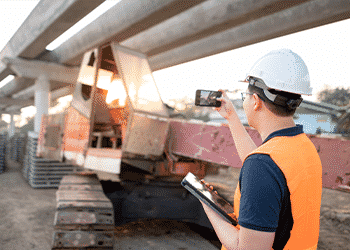It should come as no surprise that workplace safety has made its way into the mobile app space. After all, there is an app for quite literally anything you may want — from having groceries delivered to managing your bank account to arranging dry cleaning services.
Additionally, in 2021, roughly 83% of all American adults owned a smartphone, with the largest generational penetration, of course, among older Gen Zers, Millennials and younger Gen Xers. Even the majority of Baby Boomers now have a smartphone (that was not true even just three years ago).

But what are some of the benefits of utilizing mobile safety apps? Keep reading to learn how mobile apps are improving workplace safety and what to look for when deciding to implement mobile apps into your own organization.
Allows for locational flexibility
During the initial COVID-19 outbreak across the United States, millions of employees suddenly found themselves working remotely or in a more isolated capacity. As we moved back to full-capacity open spaces and events, many Americans began working in hybrid roles. However, there is still a large segment of the workforce that could never truly be successful work-from-home positions.
Simplifies access to resources
Luckily, now more than ever, mobile apps allow workers to remain efficient from anywhere. Whether you have employees working at home, all together in one location or spread across different job sites, introducing your workforce to safety apps makes it easy for everyone to complete important tasks at any level. As long as an employee has internet access, your safety program is available to them.
Traditionally, a workplace safety program likely includes multiple heavy binders listing out job expectations, safety procedures, workplace hazards, incident protocols and more. Plus you may have other printed material to post around the office or jobsite and safety handouts for employees to keep with them. However, this is truly neither practical nor effective for most organizations.
Safety apps offer one centralized location for all required — and suggested — safety material, such as contact information or emergency procedures. Mobile apps not only save time spent creating and managing physical materials, they also save your employees time spent rifling through binders and spreadsheets or traveling back and forth to a designated area where safety information is kept. Mobile apps can transform information processes, creating more informed employees with better-managed content.
Eliminates the risk of outdated information
Using mobile apps enables you to push safety updates out to all users — instantly. This saves time and money over making updates to hard-copy plans and ensuring all departments have what they need. This also can ease your mind knowing that every employee is referencing the most up-to-date information when the next incident occurs.
Additionally, when it comes to documenting occupational incidents, having only a physical log could make you unsure if what you are accessing is complete. Every year, certain occupational events must be reported to OSHA, and it is crucial for anyone in an EHS role to have accurate final numbers for their own documentation and for official submission. You don’t want to rely on questionable information when it comes to the safety of your employees.

Encourages a culture of safety
Many corporations like to tout their workplace culture as a benefit of working for them. More recently, “safety culture” has been popping up as its own trendy term, and with good reason. Safety culture is what an organization believes and does in the pursuit of safety.
According to OSHA, employees tend to demonstrate increased adherence to set safety procedures when they feel their company has a strong safety culture. By providing easy, unfettered access to your organization’s safety program, every employee can feel empowered to practice daily safety for themselves and encourage their coworkers to do the same.
Looking for more online safety training courses?
What Should You Expect From a Mobile Safety Partner?
If your organization decides that a mobile safety app is the right direction for you, then you need to select the best program for your needs. There are hundreds of safety apps currently available that help you carry out one specific task, but instead consider the benefits of utilizing an all-in-one product that simplifies safety management by providing multiple tools in one location.
Engaging content
Conducting employee training is one of the most important things any organization can do. New employees need to be trained on processes and procedures, and all employees must stay up to date on regulations. However, employee training needs to be more than just completed — it must be effective. If employees don’t take anything away from the courses, then the time and money spent on training was essentially a waste.
When it comes to EHS management platforms, employee training has never been a standard feature, but is instead more of an add-on function serving simply to check off the “employee training” boxes. In reality, training should be implemented based on the real, applicable hazards those employees will face while on the job and should be a focus of any safety program.
Job hazard analysis capabilities

In recent years, the occupational health and safety field has evolved to become more about accident prevention. Safety experts now try to focus on educating employees and identifying potential issues rather than on what is essentially damage control. Depending on your industry and your specific jobsite, there could be any number of different hazards present, including electrical equipment, dangerous goods or heavy machinery.
Conducting a job hazard analysis (JHA) will help you understand the most hazardous jobs in your workplace, what those specific hazards entail, and corrective and preventive measures you can take to reduce or completely eliminate the likelihood of accidents, injuries and illnesses. Additionally, being able to provide targeted training based on your findings provides even more opportunity for employees to learn relevant hazard mitigation techniques.
Toolbox talks
Depending on your industry, you may already be familiar with the concept of a toolbox talk, although there are many names people may use, such as tailgate briefings, safety time-outs, crew briefings or safety talks. No matter what you know them as, toolbox talks need to cover information that best applies to the group receiving the talk — and that’s it. For example, a construction crew might need to discuss trenching hazards while it would be more beneficial for office workers to learn about ergonomics.
It is up to each organization to determine what makes the most sense for them, but incorporating toolbox talks into your regular work schedule truly is as easy as it sounds. Whether you decide to start with monthly toolbox talks or increase meetings to weekly or daily, you can feel comfort in knowing the more your team talks about safety, the higher a priority safety becomes.
Incident management documentation
While OHS has begun putting emphasis on recognizing and eliminating hazards before they can become an issue, accidents do still happen. And when they do, everyone needs to be prepared. Complete and accurate reporting ensures the incident is resolved properly and can show where additional training or safety precautions may be needed.
Unfortunately, not all companies have clear and consistent incident management procedures. Finding a partner who can provide straightforward, easy-to-use documentation will make it easy for any employee, at any level, to understand what steps must be taken. After all, you never know who might be involved in an incident, and therefore who might need to make the official report.

Easy OSHA reporting tools
Because OSHA inspections can result in potentially serious fines, it is crucial for every employer to understand which incidents need to be tracked for company records, what documentation must be submitted directly to OSHA and anything in between.
Working with an online training partner who understands the importance of maintaining accurate records will help when the inevitable day comes when an OSHA inspector arrives at your door — or when putting together a report on a workplace incident.
Don’t Get Bogged Down by Multiple Safety Apps
A full-service mobile app that offers numerous functions may seem like it would be overwhelming to introduce and implement within your organization, but it certainly doesn’t have to be. After more than 35 years of providing engaging and effective safety training content to companies around the world, the experts at SafetySkills wanted to offer one complete solution that creates an invaluable holistic approach to safety management.
SafetySkills Empower is designed to be utilized by both longtime safety experts and by those with no industry experience. The lightweight design means the full suite is ready to go upon implementation, without having to wait a year or longer before reaching its full use potential for your business. The interface is user-friendly and utilizes standard terminology that matches industry-wide best practices.
No matter how many employees your team includes, and regardless of your past safety record, SafetySkills can help you create an intuitive, functional and effective outcome-based safety training program.


